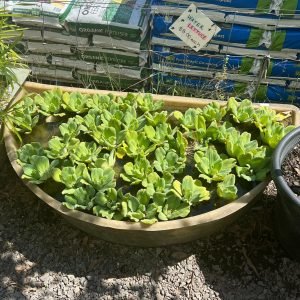Water features and ponds are seeing a resurgence, especially with a focus on natural beauty, to bring back native wildlife. Along with water features comes an abundance of beautiful water plants, with such a wide and vivid variety to choose from, and it can be difficult to know which ones to choose. So today, we are going to discuss the 10 easiest water plants to grow at home!
1: Water Lily
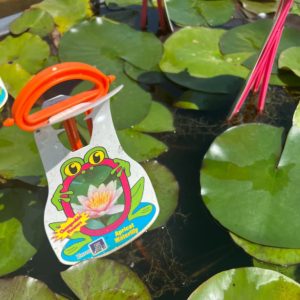 One of the prettiest and most well-known water plants, the hardy and humble water lily can grow anywhere. From slimy dams and muddy pots to stunning ponds, these plants produce glossy green floating leaves and gorgeous flowers that rest peacefully on top of the water. They make an absolutely gorgeous addition to any garden. Water Lilies spread via a creeping rhizome to all areas of the dam, pot, or pond, wherever the water is at the right depth. If the water is too shallow, your waterlily won’t do well, if the water is too deep, it won’t grow. Try to keep them at a depth of at least 30cm.
One of the prettiest and most well-known water plants, the hardy and humble water lily can grow anywhere. From slimy dams and muddy pots to stunning ponds, these plants produce glossy green floating leaves and gorgeous flowers that rest peacefully on top of the water. They make an absolutely gorgeous addition to any garden. Water Lilies spread via a creeping rhizome to all areas of the dam, pot, or pond, wherever the water is at the right depth. If the water is too shallow, your waterlily won’t do well, if the water is too deep, it won’t grow. Try to keep them at a depth of at least 30cm.
Water Lilies like full sun and must be kept wet at all times, and excess drying out can result in dormancy or even death.
To plant your waterlily, choose a sunny spot in your pond or dam. Scoop some mud or substrate out of the way and place the waterlily in position. This will stir the water up a little, but it will settle after planting. Once your water lily is in position, you can lay some pebbles or rocks over the disturbed mud/substrate. These will also help hold the waterlily in place until the roots take hold, which won’t take too long.
If your pond/dam is big enough, we recommend adding some fish to the water. Not only will they add a dash of colour and life, but they will also help keep mosquito larvae in check. Remove any spent flowers or old leaves as the lilies age and prune regularly.
2: Water Lettuce
Water lettuce is a fun plant that is commonly found in slow-moving waters around ponds, ditches, lakes, and canals. It originates from the Nile River, and today it’s found throughout the world, thriving in tropical environments. It makes an attractive water plant in backyards around water features where its rapid growth can be controlled.
Water lettuce is a perennial evergreen that forms in large, floating colonies. It has spongy foliage that is light green to grey-green coloured and is around 2.5-15cm long. Its floating root structure can grow up to 51cm in length, while the water lettuce plant itself covers an area of nearly 3.5m. Its leaves form velvety looking rosettes that look like heads of lettuce, which is how it got its name. Water lettuce has small yellow flowers hidden in the foliage, and they bloom from late summer to early winter.
In warm climates, water lettuce grows happily in an aquatic environment in a mix of moist loam and sand, with water temps between 19-22°C. Otherwise, water lettuce doesn’t need much care other than pruning back.
3: Japanese Sweet Flag
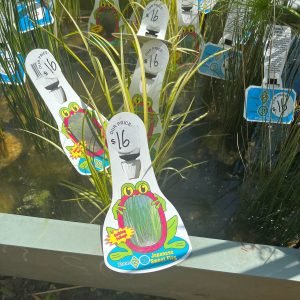 This stunning water plant has silvery-green leaves with creamy-white stripes. It reaches 30cm tall and loves full sun to part shade. Japanese Sweet Flag thrives in shallow waters around the edges of ponds, dams, and wetlands, in water 5-10cm deep. You can also grow a Japanese sweet flag in a decorative pot with no hole. When growing it in a pot, you need to treat the sweet flag like another potted plant, just growing in water instead of soil.
This stunning water plant has silvery-green leaves with creamy-white stripes. It reaches 30cm tall and loves full sun to part shade. Japanese Sweet Flag thrives in shallow waters around the edges of ponds, dams, and wetlands, in water 5-10cm deep. You can also grow a Japanese sweet flag in a decorative pot with no hole. When growing it in a pot, you need to treat the sweet flag like another potted plant, just growing in water instead of soil.
The Japanese sweet flag is frost tolerant and is considered to be good feng shui. The plant goes dormant in the winter and will shed its leaves. Plant your Japanese sweet flag straight into the base of the dam or pond. If you can’t get into the dam or pond to dig a hole to plant the Japanese sweet flag, you can use a tent peg to hold it down. Most ponds and dams will give enough nutrients for your plant to thrive, however, yabbies love new Japanese sweet flag, so if you suspect your pond or dam has yabbies, place a fine mesh cage around your water plant. The mesh will need to be large enough for the new leaves to grow through but small enough that yabbies can’t get through. Once your Japanese sweet flag is established, the yabbies should lose interest.
4: Grey Sedge
Also known as lepironia articulata or twizzler, this gorgeous, tall water plant forms large, dense swords of foliage. It grows in stunning, ephemeral swamps and on the margins of freshwater swamps. It is highly ornamental and is the perfect designer water feature plant. Grey sedge prefers full sun to part shade and is native to Queensland. It will grow anywhere as long as it is protected from heavy frost. It prefers acid sulphate soils. The grey sedge flower spike is 1-3cm long and grows near the tip of the stem. It flowers in spring, summer, and autumn and is considered one of the best native plants for backyards and for planting around water features. It is also salt water tolerant.
5: Water Poppy
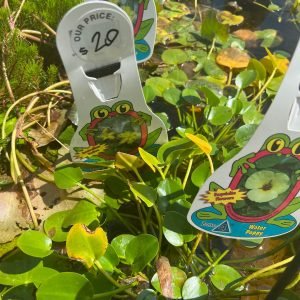 An inviting outdoor space is a must for all gardeners. And when it comes to turning a pond into a stunning outdoor feature, there’s nothing better than planting water poppies. Water poppies are stunning, ornamental plants that are not only lovely additions to your waterscape but also help prevent algae growth and aid in water filtration. Native to Central and South America, water poppies produce a multitude of flat leaves with a glossy texture. They have cheerful, yellow leaves that spring from the mass of foliage when water temperatures reach 21°C. These three-petaled flowers only flower for one day. The water poppy will continue to produce flowers throughout the entirety of the summer growing season.
An inviting outdoor space is a must for all gardeners. And when it comes to turning a pond into a stunning outdoor feature, there’s nothing better than planting water poppies. Water poppies are stunning, ornamental plants that are not only lovely additions to your waterscape but also help prevent algae growth and aid in water filtration. Native to Central and South America, water poppies produce a multitude of flat leaves with a glossy texture. They have cheerful, yellow leaves that spring from the mass of foliage when water temperatures reach 21°C. These three-petaled flowers only flower for one day. The water poppy will continue to produce flowers throughout the entirety of the summer growing season.
Water poppies can be grown in any pond with a shallow bottom, however, they grow best when grown in water at least 15cm deep. Select a location within the pond that receives direct sun, as water poppies love direct sunlight. Bare rooted water poppies can be submerged and planted directly into the soil or placed into pots with soil which can later be sunk into the pond.
6: Water Hyssop
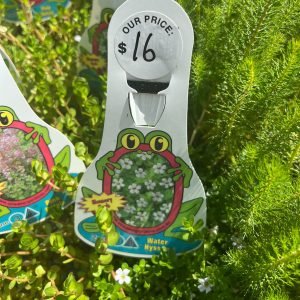 Another gorgeous ornamental flower, water hyssop, is a creeping, mat-forming perennial plant native to warm wetlands worldwide. Stunning, small succulent leaves cover stems that extend up to 4 feet, and small bell-shaped white flowers bloom from spring to autumn (in warmer climates, they bloom all year round). This adaptable plant can grow in moist soil as well as completely submerged in water up to 12 inches deep. Water hyssop is tolerant of even the most brackish water and is a fast-growing species that can be planted at almost any time.
Another gorgeous ornamental flower, water hyssop, is a creeping, mat-forming perennial plant native to warm wetlands worldwide. Stunning, small succulent leaves cover stems that extend up to 4 feet, and small bell-shaped white flowers bloom from spring to autumn (in warmer climates, they bloom all year round). This adaptable plant can grow in moist soil as well as completely submerged in water up to 12 inches deep. Water hyssop is tolerant of even the most brackish water and is a fast-growing species that can be planted at almost any time.
This versatile water plant can be used in and around ponds, dams, water gardens, aquariums, and even as a filler in hanging baskets. It is also not toxic to humans or animals, making it perfect for pet owners and families with small children!
7: Amazon Queen
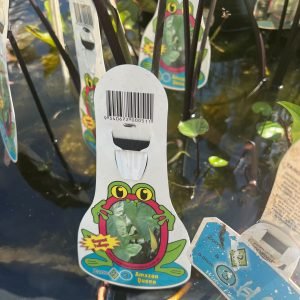 The Amazon Queen is truly the queen of water plants, featuring deep green leaves and deep purple stems. It blooms gorgeous yellow flowers in late summer and can grow up to 2m tall. It prefers a semi-shaded position in shallow waters around the edges of ponds, wetlands, and dams in waters 5-10cm deep. It can also be used as a decorative pot plant, in a pot without a hole. Like we recommended with the Japanese sweet flag, when growing the Amazon Queen in a pot, treat it like you would any other pot plant, just with water instead of soil.
The Amazon Queen is truly the queen of water plants, featuring deep green leaves and deep purple stems. It blooms gorgeous yellow flowers in late summer and can grow up to 2m tall. It prefers a semi-shaded position in shallow waters around the edges of ponds, wetlands, and dams in waters 5-10cm deep. It can also be used as a decorative pot plant, in a pot without a hole. Like we recommended with the Japanese sweet flag, when growing the Amazon Queen in a pot, treat it like you would any other pot plant, just with water instead of soil.
Amazon Queen is not frost tolerant and will go dormant in winter in the southern states of Australia.
8: Dwarf Papyrus
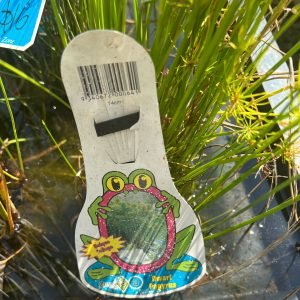 This adorable evergreen water plant grows up to 45cm tall and features a little tassel head-on grass-like stems. It is popular with gardeners who want to provide shelter for fish or encourage frogs to your pond and provide shelter for them too.
This adorable evergreen water plant grows up to 45cm tall and features a little tassel head-on grass-like stems. It is popular with gardeners who want to provide shelter for fish or encourage frogs to your pond and provide shelter for them too.
It loves full sun to part shade and grows in shallow waters around the edges of dams, wetlands, and ponds. Like the Japanese sweet flag, and the Amazon Queen, Dwarf Papyrus can be grown in pots without a hole, so you can grow stunning water plants on a balcony and enjoy them as much as growing them around a larger water feature like a dam or pond.
The dwarf papyrus is frost-sensitive and may go dormant or die off during winter months if temperatures drop.
When planting in a dam or pond, be sure to plant with a mesh around your plant to protect it from yabbies until the plant is established.
9: Lotus
The lotus is a classic water plant we all immediately think of when we start looking for water plants. This aquatic plant is well known for its visually interesting leaves and stunning flowers. However, growing lotus plants requires a certain amount of diligence and patience. These plants will also spread quickly and become invasive, so it’s best to grow them in containers with no drainage holes, so the roots can’t escape.
When growing from rhizomes, fill a container with garden soil and lightly cover it with rhizomes, leaving the pointed tips slightly exposed. Submerge the container in water to make the surface about 5cm above the soil line. Put a layer of gravel on top of the soil to keep it from floating away. After a few days, the first leaf should emerge. Keep raising the water level slowly to match the length of the lotus stems. Once the lotus has reached maturity, sink the container into your pond, water garden, or dam no more than 45cm from the surface (you may need to raise the container on bricks).
Caring for lotus is relatively easy. They love full sun and only need moderate fertilising. Lotus tubers, however, can’t survive freezing, but as long as your pond doesn’t freeze over, they should be fine through winter.
10: Katniss
Katniss isn’t just the name of a young adult book heroine. Katniss is also a water plant with arrow-shaped leaves and white, three-petaled flowers that all grow on a long, upright stalk. This plant goes by many names, including Sagittaria sagittifolia, arrowhead, duck potato, swan potato, wapato, and tule potato. The tubers of katniss are edible and have been used by Indigenous Americans as a food source, very similar to potatoes, for generations.
Katniss prefers rich, wet environments, making them an excellent choice for water gardens, rain gardens, and low lying dams that get flooded regularly. Their roots need to be in standing water for at least part, if not all, of the year. They prefer full sun but will tolerate some shade. However, it will grow in a shady location but it will flower less.
Once its roots have taken hold, katniss need little care, as long as they get sufficiently wet soil occasionally. Once established, the plant will naturalise with your garden and will spread either by rhizomes or self-seeding. If you don’t want your katniss to spread, you need to remove flower stalks as soon as flowering has finished.
–
Are you looking to create the perfect water feature in your backyard? Whether you are creating a pond, rain garden, water garden, or you want to bring some beauty back to your dam, Aumann’s has a wide variety of water plants available for you. Visit us in-store or contact us today for help and advice or to view our range of plants. We are excited to help you to create the garden of your dreams!


